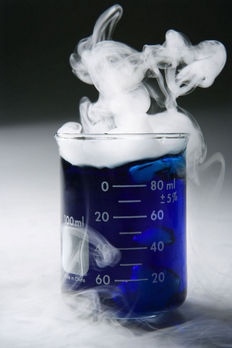
by Professor String


by Professor String |
Want to put some heat on your tone? Try some Frozen Strings. |
|
Frozen
Strings have become one of the hottest things in guitar and bass string design.
It’s no pun! We are talking about cryogenically tempered strings. Some of the
first sets of cryogenically tempered strings hit the market about two decades
ago. But they really did not get into the mainstream of visibility until about a
decade ago. Since that time, many players have found the merits of using these
uniquely made strings. At the same time, many players are still unfamiliar with
cryogenically tempered strings. We are going to take a closer look at this
innovation mostly misunderstood by many and often mistaken as another string
gimmick.
So what are cryogenically tempered strings (also called cryogenic strings)? They
are strings that have been taken from room temperature, to extremely cold
temperatures (about -320 degrees Fahrenheit) for about fifteen hours. Once the
strings have fully temperature soaked, they are slowly brought back to room
temperature over a period of fifteen hours. The whole thermal cycle process
takes about thirty seven hours to complete. The cryogenic process addresses five
things from a metallurgical perspective:
1. It closes and refines grain
structures within the alloy.
2. There is a reduction in retained
stresses, wear and surface roughness.
3. It reduces retained austenite in
the metal.
4. Increases dimensional stability
5. Increases overall durability
In theory, this means the string will achieve a greater stability in tuning as
it is brought to full tension. In addition, the tone will not decay as quickly
as the strings begin to age.
The Frozen Unknown
As mentioned earlier, many players are still unfamiliar with cryogenic strings.
For the most part, the strings have made significant inroads into the electric
bass market. They have become popular with many bassists wanting to retain a
bright sound after countless hours of slapping and string popping. They are a
little pricier than regular strings due to the extra process time required to
make the strings. If a player is not aware of the story behind cryogenic
strings, then paying a little extra might not make sense. This is true of any
product being marketed. But, by word of mouth and Internet forums, the strings
have become known, and proven, for their extended life expectancy. In addition,
they have started to gain a reputation for quicker stability in tuning…two of
the most desired traits wanted by musicians. Interestingly, the bottom line in
sales figures for cryogenic strings has been good, but not overwhelming in
recent years. Look no further than to see the continued limited offerings in
this string segment. Cryogenic flat wounds and acoustic sets are virtually a “no
show” in the cryogenic string market. The sales numbers have not made it
justifiable to expand into these offerings. Why? Take a look at the marketing
campaigns trying to sell the strings. Getting the idea of freezing strings to
mean something to the weekend guitarist or bassist is a tall order. Instead of
taking the problem head-on, string marketers have leveraged the tired and lazy
old fashioned method of selling the strings: Get a celebrity endorsement to say
how fabulous the strings play. This risk is having cryogenic strings take on an
image of being just another gimmick. Are they missing a real opportunity? Maybe.
Cryogenic strings represent one of the more innovative metallurgical processing
improvements in string performance. It’s curious that they have not been
marketed as a solution, but as just another flavor on the string menu.
Cryogenic Bass
For bass players, slap style has long been the test for string durability and
tuning stability. The continuous beating and snapping of the strings against the
frets takes a toll. For many bassists doing slap, a crispy clean sound (aka.
Marcus Miller) with plenty of bite is desired from the strings. More
importantly, the ability of the string to stay in tune is critical. The tone is
easy to achieve with a brand spanking new set, or a set with minimal playing
time. However, the tunability of a newer string is an issue until it is goes
through a period of break in. As the string starts to age, the tuning starts to
stabilize, but the crisp clean tone starts to fade. For the professional
musician with extremely deep pockets and a personal bass technician, it’s never
a problem…just simply put another new set on the instrument. However, for those
players on a shoe string budget (or, bass string budget!) changing strings after
a few sessions is not financially practical. For many bassists, the answer has
been cryogenic strings for tone stability and tunability over extended periods
of time. Cryogenic strings do not solve all the issues with bass strings, but
they do present a more focused solution towards the lifecycle of a bass string.
Cryogenic Guitar
Many guitarists have not become familiar with the merits of cryogenic strings.
Guitarists have different string problems than electric bass players. There are
so many different desired tones and sounds players seek. The tone can range from
soft warm bell tones to ultra bright rip-your-head-off shrill. Regardless of the
tone desired the problems remain with tunability and string life. For many
guitarist, bending and tremolo bar usage takes a toll on string life. For these
players, cryogenically tempered strings may offer some relief. Unfortunately, it
is a Herculean marketing task to get the message across about how cryogenic
tempering can help. Here are some of the barriers to getting the message across
to players:
|
|
|
|
To
conclude this section, I’ll refer to the statement made at the end of the
Cryogenic Bass paragraph: Cryogenic strings do not solve all the issues with
guitar strings, but they do present a more focused solution towards the
lifecycle of a guitar string.
If you are a guitarist or bassist, and you have not tried a cryogenic set of strings, give’em a test drive. Who knows, maybe you’ll stumble upon a string secret your fellow players do not know about.
Do you have some thoughts about this article or the subject? Share it with everyone on the Professor's Forum.
|